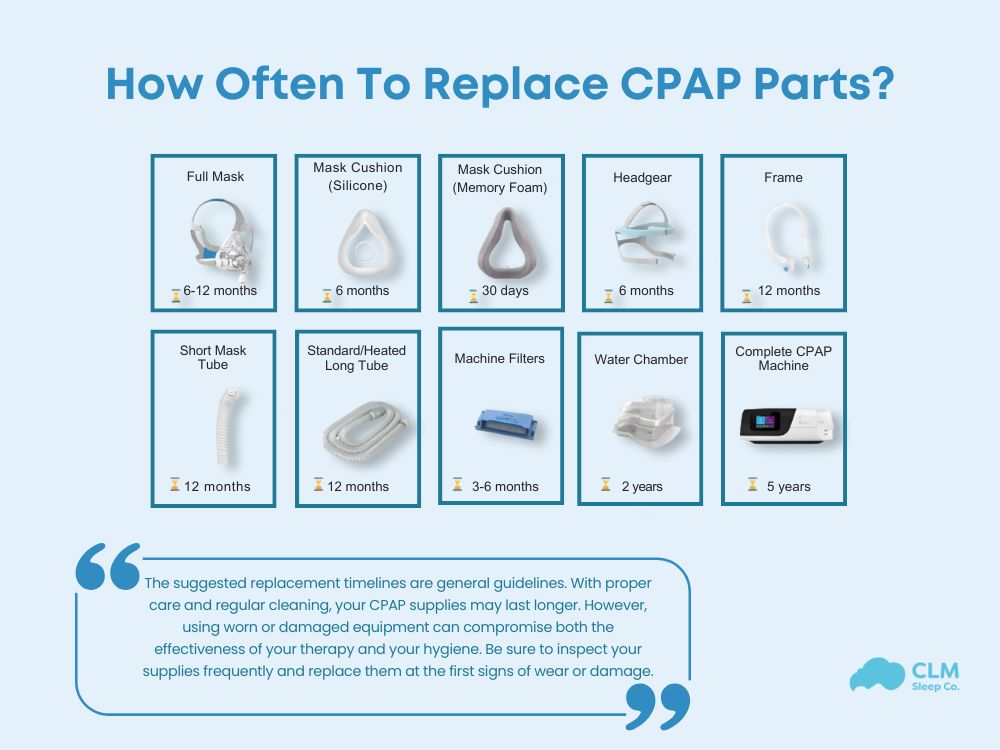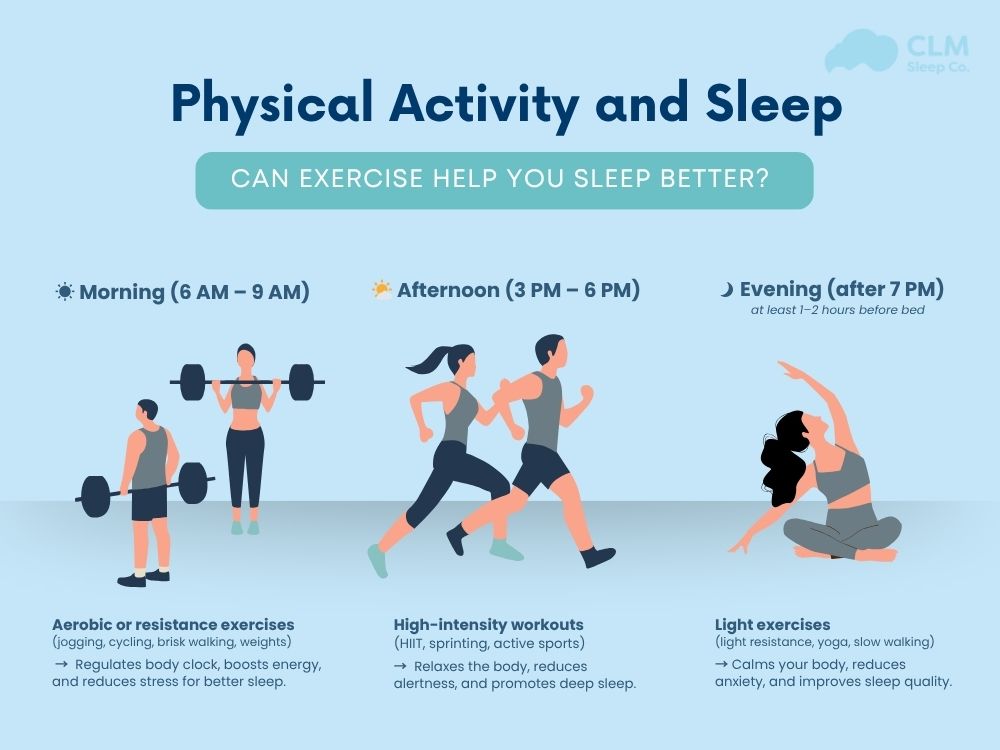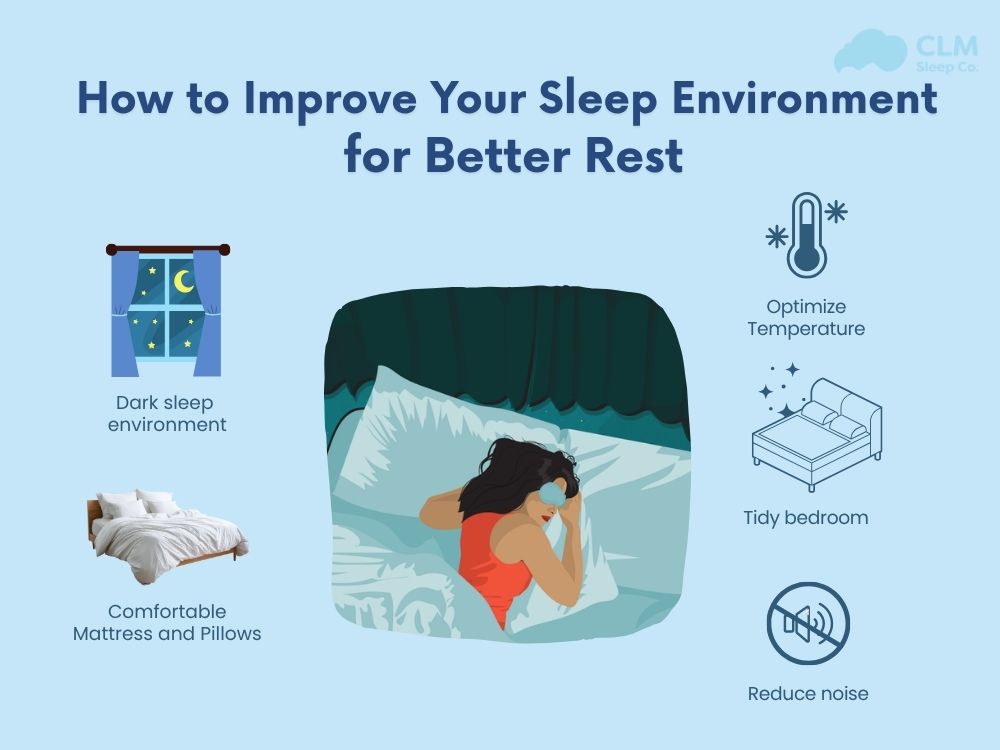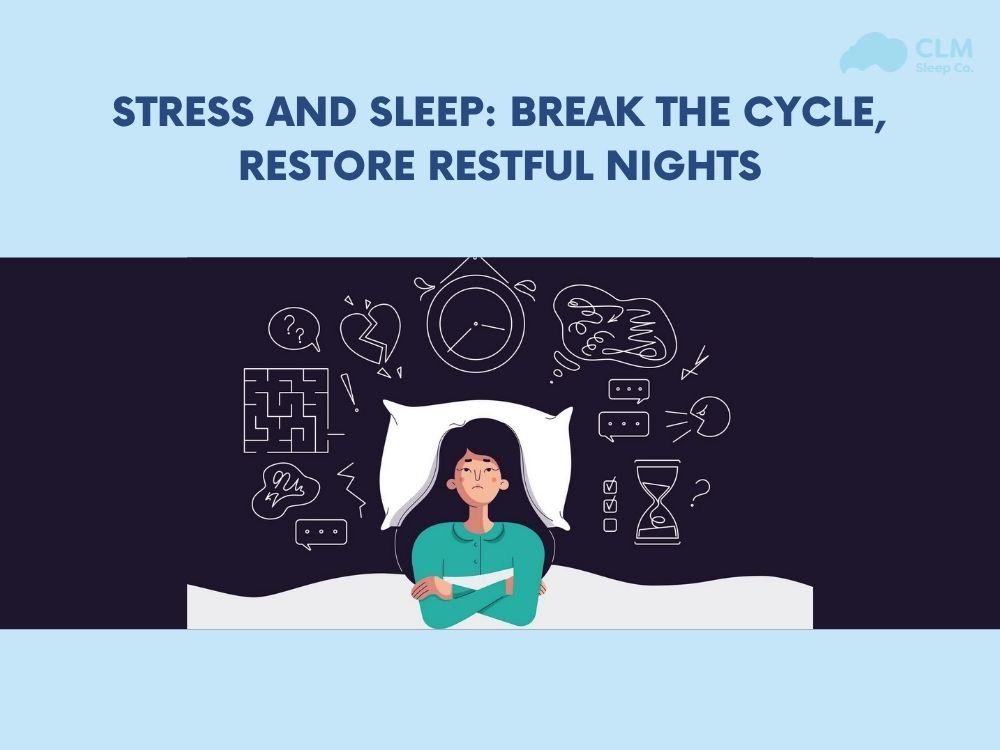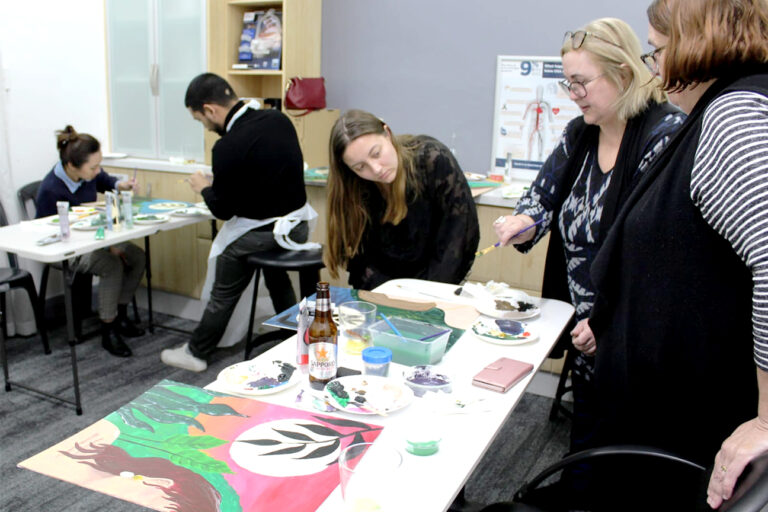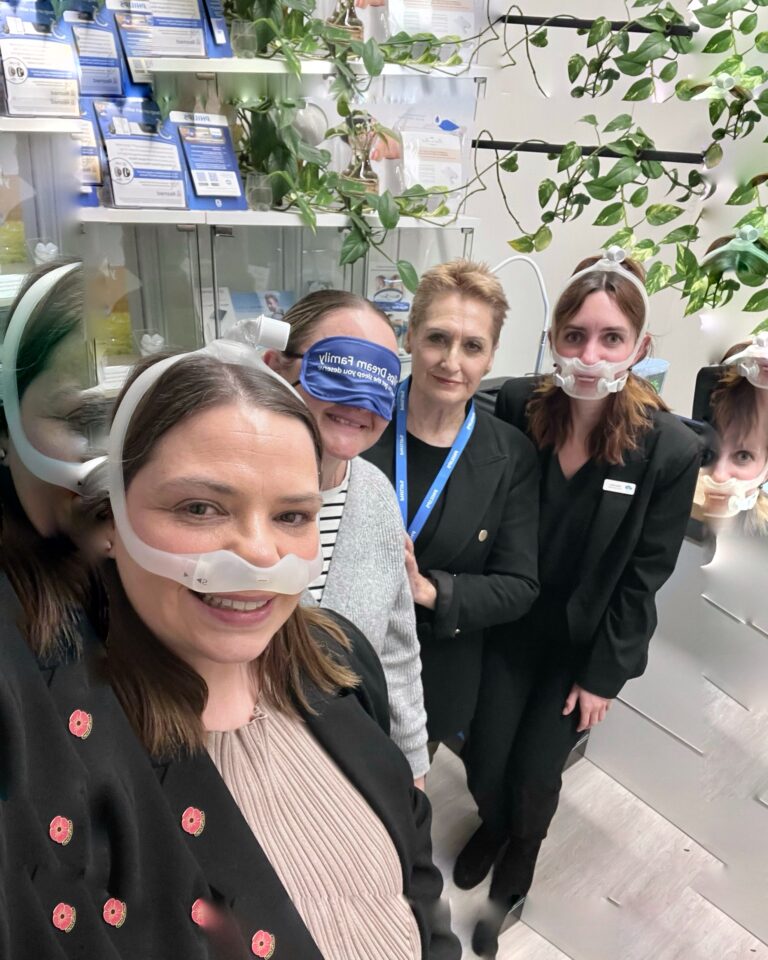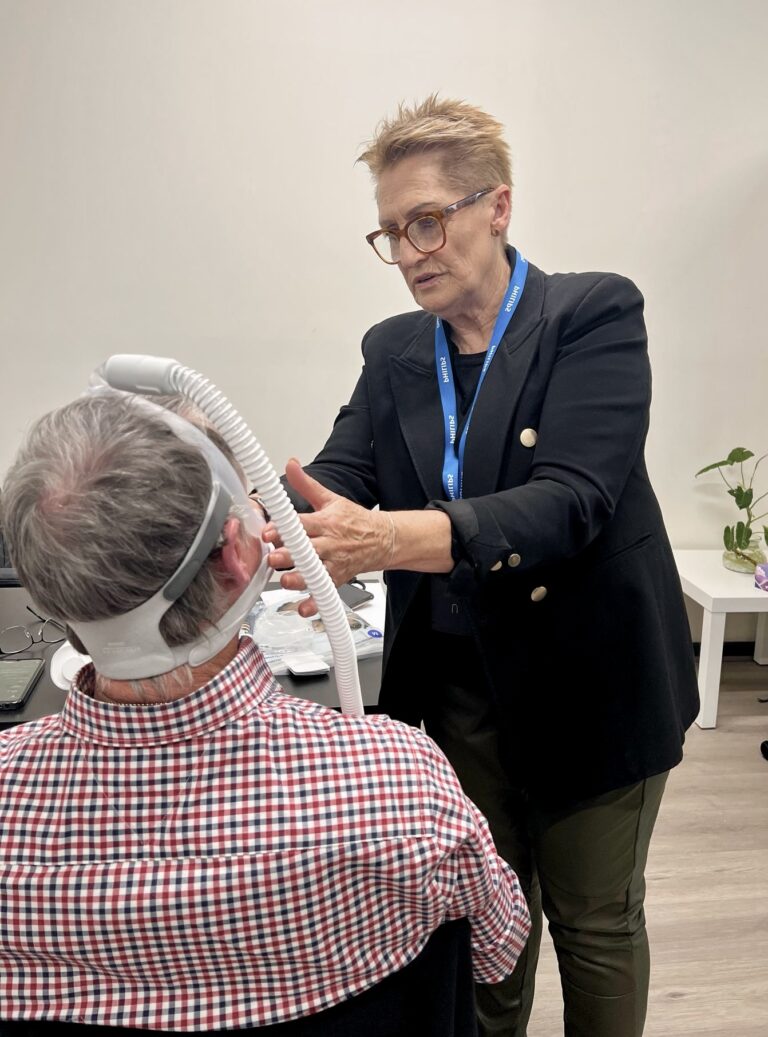Using a CPAP machine is a vital step in treating obstructive sleep apnea, but proper maintenance is just as essential. One key overlooked aspect is knowing when to replace essential parts like masks, filters, and tubing. These components wear down over time due to regular use, moisture, and skin oils, leading to leaks, discomfort, reduced effectiveness, and potential health risks. In this CLM Sleep guide, we’ll cover how often to replace CPAP parts, signs of wear to watch for, and how regular replacements can help you stay on track with your therapy.
CPAP machine overview
What is a CPAP machine? A CPAP machine is a device that delivers continuous positive airway pressure. It connects to a mask through a tube, you need to wear it while you sleep. The machine provides a steady stream of air through the mask into your airway, keeping the airway open and helping prevent episodes of apnea or snoring during sleep.
According to several studies published in the Journal of Clinical Sleep Medicine and Frontiers, CPAP therapy is widely recognized as the most effective treatment for obstructive sleep apnea. This therapy, in addition to improving sleep quality and reducing excessive daytime sleepiness, also helps lower blood pressure and reduce the risk of cardiovascular diseases. However, the effectiveness of CPAP therapy depends heavily on the proper maintenance and timely replacement of its components. Over time, CPAP parts are subject to wear and tear, accumulation of facial oils, and exposure to moisture, all of which can reduce their performance and hygiene. Knowing how often to replace CPAP parts will help you ensure consistent treatment results, minimize the risk of infection, and maintain comfort.
See more: Best Sleep Apnea Machine For 2025
Why is replacing CPAP parts regularly important?
Replacing the parts of the CPAP machine according to the manufacturer’s recommended schedule not only keeps your device safe and hygienic. But it also directly affects the treatment effectiveness, comfort, and lifespan of the machine.
Ensure treatment effectiveness
After a period of use, the parts of the CPAP machine will degrade. For example, the cushion may wear out or lose its seal, causing air leaks. The filter may accumulate dust and discolor, reducing its filtering capacity. The humidifier chamber may accumulate mineral deposits, become discolored, or crack. These issues will reduce the treatment effectiveness, causing an unstable airflow, leading to discomfort, and potentially causing the symptoms of sleep apnea to reappear. Therefore, regularly inspecting and replacing the parts of the CPAP machine is essential, helping the machine maintain accurate air pressure and optimal performance.
Maintain a sense of comfort
Comfort is an important factor for you to maintain CPAP therapy accurately and consistently. An old mask or stretched straps can cause the mask to shift, making you uncomfortable or leaving marks on your face. Additionally, air leaks are also a common occurrence when CPAP parts are not replaced according to the manufacturer’s recommendations. The escaping airflow will create noise, and when it blows onto the skin or eyes, it will cause dryness or even irritation. That’s why you need to pay attention to regularly replacing CPAP parts.
Ensure hygiene factors
After a period of use, some devices will become discolored, accumulate dirt, and harbor bacteria. Therefore, it is necessary to replace CPAP parts and regularly clean them to avoid the accumulation of bacteria or mold, reducing the risk of infection, allergies, and respiratory health issues.
Extend the lifespan of the CPAP machine
Replacing consumable components reduces strain on the CPAP device itself. For example, clogged filters or leaky hoses can force the machine to work harder, potentially shortening its lifespan or leading to costly repairs.

See more: ResMed AirSense 10 Parts
Key CPAP parts and their replacement frequency
Understanding how often to replace CPAP parts as well as the signs to watch for will help you easily stay compliant with your therapy and achieve optimal results during the treatment process.
Mask (Nasal, Pillow, or Full-Face)
The CPAP mask consists of many parts such as cushions, headgear, frame, elbow, and swivel. Some parts such as cushions, headgear, and frame can be replaced individually when damaged. The main cause of air leaks or discomfort when wearing the mask is usually the cushions, as over time the cushion edges lose their elasticity and tightness. You need to consider the condition of the mask and your financial situation before deciding whether to replace the entire mask or just the damaged part. If you replace the cushions regularly, you can extend the overall lifespan of the mask by 6–12 months.
However, you should replace the entire mask immediately when: The vent is blocked or damaged.
- Swivel/elbow is loose, leaking air, or making noise.
- Some parts are yellowed and difficult to clean.
- The mask has been used for over 12 months.
On the contrary, if the frame is cracked, broken, or warped; the headgear is excessively stretched or torn; the cushions are yellowed or do not fit properly, you only need to replace the damaged parts.
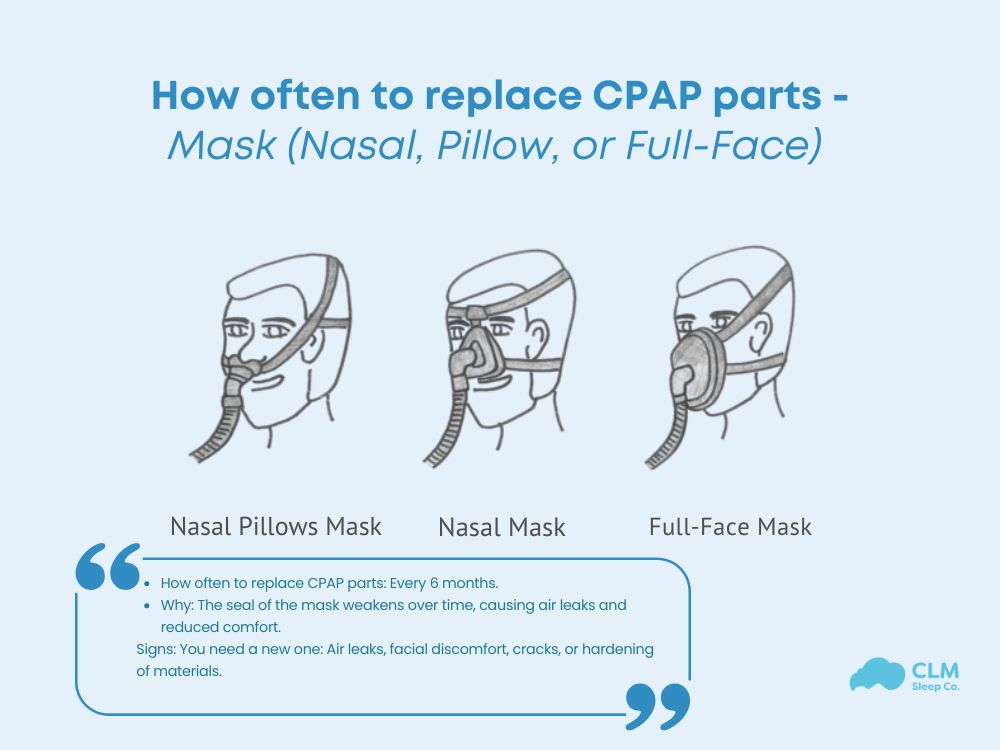
Read more: Things to know about F&P Nova Micro
Mask Cushions
Mask Cushions are the parts that need to be replaced most frequently because they come into direct contact with your face every day. A standard cushion must provide you with a comfortable feeling, fitting snugly on your face without causing pressure or leaving marks. There are two types of cushions made from different materials, so the replacement time for each type is also different.
Silicone Cushions
Silicone Cushions are the most commonly used type of cushion for CPAP masks. Because it is made from soft, safe medical silicone, hypoallergenic, easy to clean, and fits snugly on the face while still being extremely comfortable. However, the cushions come into direct contact with oil, sweat on the skin, and cleaning agents every day, which will gradually lose their elasticity, leading to air leaks. Therefore, it is necessary to replace the Silicone Cushions regularly every 2-4 weeks. However, if you notice the cushions are leaking air, changing colour, cracking, or causing discomfort, you should replace them sooner than this timeframe.
Memory Foam Cushions
Memory foam cushions are softer are softer and mould to your face more closely than silicone ones. However, the foam material is soak up moisture and is difficult to clean, so bacteria can easily grow if it is not replaced regularly. Unlike silicone cushions, you should not wash foam cushions with water or soap, but instead wipe them gently with a damp cloth or a specialized cloth; otherwise, the foam will deteriorate more quickly. For best comfort and hygiene, replace Memory Foam Cushions every 30 days. Additionally, if you notice any signs of damage, peeling, or air leakage, you can replace them sooner.
Headgear
The headgear will help secure and keep the mask from shifting. However, the elastic part of the strap will stretch and gradually lose its elasticity over time, causing the mask to shift easily while sleeping. This can cause air leaks, reduce treatment effectiveness, and create discomfort when wearing. You should replace the strap after about 6 months of use or sooner if you notice the strap is loose, the mask is slipping, or the fabric is frayed.
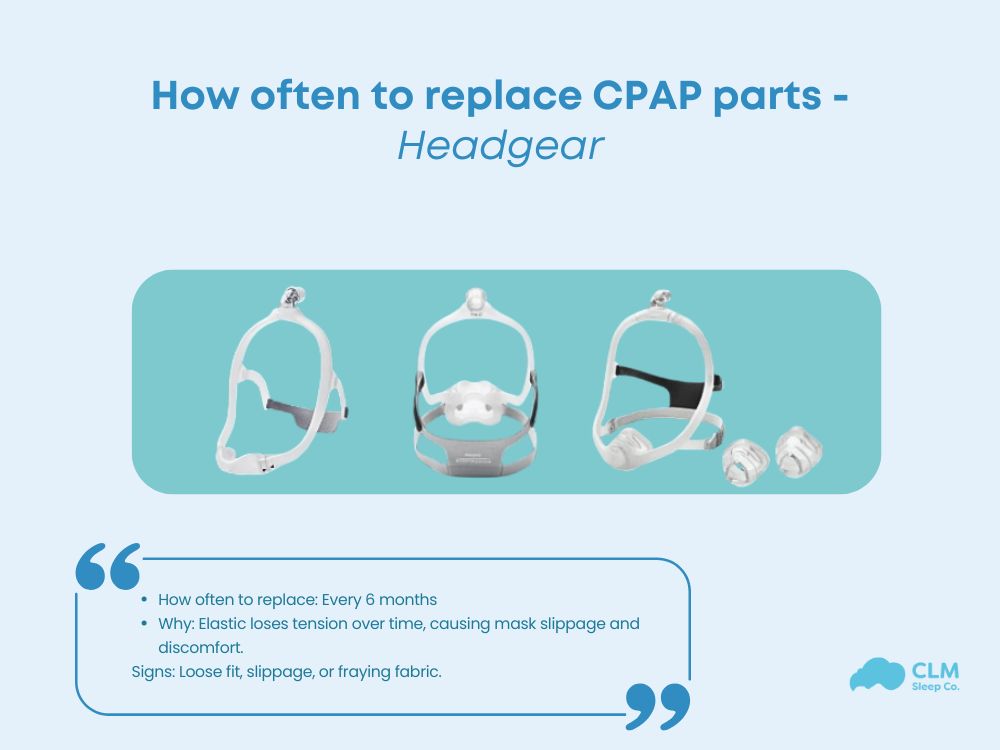
Frame
The CPAP mask frame helps hold and supports the other parts of the mask, such as the cushion and headgear. Regular use and cleaning can cause the frame to deform or crack. This can make it harder for the mask to stay in place, leading to air leaks and reduced treatment effectiveness. If you notice the frame is misshapen, damaged, or no longer holding the mask securely, it’s best to replace it. Most mask frames should be replaced every 3 to 6 months.
Short Mask Tubes
The short tubes connects the long tubes to the mask, with a short and soft design that helps reduce the pull on the mask and provides more comfort when turning or changing sleeping positions. Due to frequent twisting or bending, the tube can become stiff and crack over time, causing air leaks and reducing sleep comfort. You will need to replace the tube if you hear a air leak when the machine is operating, the tube becomes hard and difficult to bend, or cracks appear. Even if there are no unusual signs, you should still replace the tube regularly every 3 months.
Standard or Heated Long Tubes
Standard long tubes are simply extension tubes used to direct the airflow from the machine to the mask. Heated long tubes are similar to Standard long tubes but with built-in heating wires. Long tubes are prone to hardening, cracking, or leaking due to bending, stretching, or twisting. At the same time, long tubes are very difficult to clean and easily accumulate bacteria and mold. Therefore, CPAP tubing need to be replaced periodically every 6-12 months. However, they should be replaced sooner if you notice signs such as air leaks, blockages, stiff tubes, loss of flexibility, discoloration, unusual odors, or mold growth.
Air Filters
The CPAP mask filter helps trap dust, including fine particles such as pollen, before the air enters the machine. This reduces irritation to the nose and throat and helps prevent respiratory inflammation. The filter also protects the CPAP machine, preventing dust from entering and ensuring it runs smoothly and lasts longer. There are two commonly used types of filters are disposable filters and reusable filters.
Disposable Filters
This is a disposable filter, with an average replacement time of about 2–4 weeks. This filter is thin and easily clogged by accumulated dust, so it is important to replace it at the right time. You should replace the filter if you notice weaker airflow than usual or visible dust on the filter surface. Another sign is experiencing sneezing or nasal itching when using the machine.
Reusable Filters
This type of filter is made from more durable material, can be removed and washed for reuse. After a period of use, Reusable Filters will wear out, deform, or lose their filtering ability, allowing dust to easily enter the machine. If cleaned regularly, Reusable Filters can be used for up to 6 months. Some signs to recognize that the filter needs to be replaced are a warped or torn filter surface, or if dirt still clings tightly despite cleaning.
Humidifier Chamber
The water chamber of the humidifier should be replaced approximately every 6 months. During use, minerals in the water can accumulate as deposits on the walls and bottom of the chamber, especially if tap water is used. Additionally, the humid environment inside also easily creates conditions for mold or bacteria to grow.
Signs that the humidifier chamber needs to be replaced include the water chamber surface becoming cloudy or showing cracks and deformation. You may also notice white residue or stains that cannot be cleaned. Replacing the water chamber at the right time ensures that the moisture produced is clean and does not irritate the respiratory tract. This helps maintain the effectiveness of your treatment.
Additional tips for maintaining CPAP equipment
In addition to replacing CPAP parts on schedule, proper daily and weekly maintenance is essential. It plays a vital role in keeping your device effective and hygienic. Taking just a few minutes each week to clean and inspect your equipment can prevent performance issues. It also helps reduce health risks and extend the life of your CPAP machine. Here are some practical tips to help you care for your CPAP gear more efficiently:
- Routine cleaning: Once a week, disassemble your mask, tubing, and humidifier water chamber. Wash each part with warm water and a mild, fragrance-free detergent. Avoid using harsh chemicals like bleach, vinegar, or alcohol-based cleaners, as these can degrade the materials and cause irritation when inhaled.
- Dry completely: After cleaning, ensure all components are completely dry before reassembling. Lay the parts on a clean, dry towel in a well-ventilated area and allow them to air dry naturally. Moisture left in the system can promote mold and bacteria growth.
- Leak checks: Regularly examine your mask and tubing for signs of wear or damage, such as small holes or cracks. Also, check the mask fit during use air leaks can reduce therapy effectiveness and cause discomfort or noise.
- Avoid sunlight: Store your CPAP machine and accessories in a cool, dry location, away from direct sunlight or extreme temperatures. Heat and UV exposure can degrade plastic and silicone materials, shortening the life of your equipment.
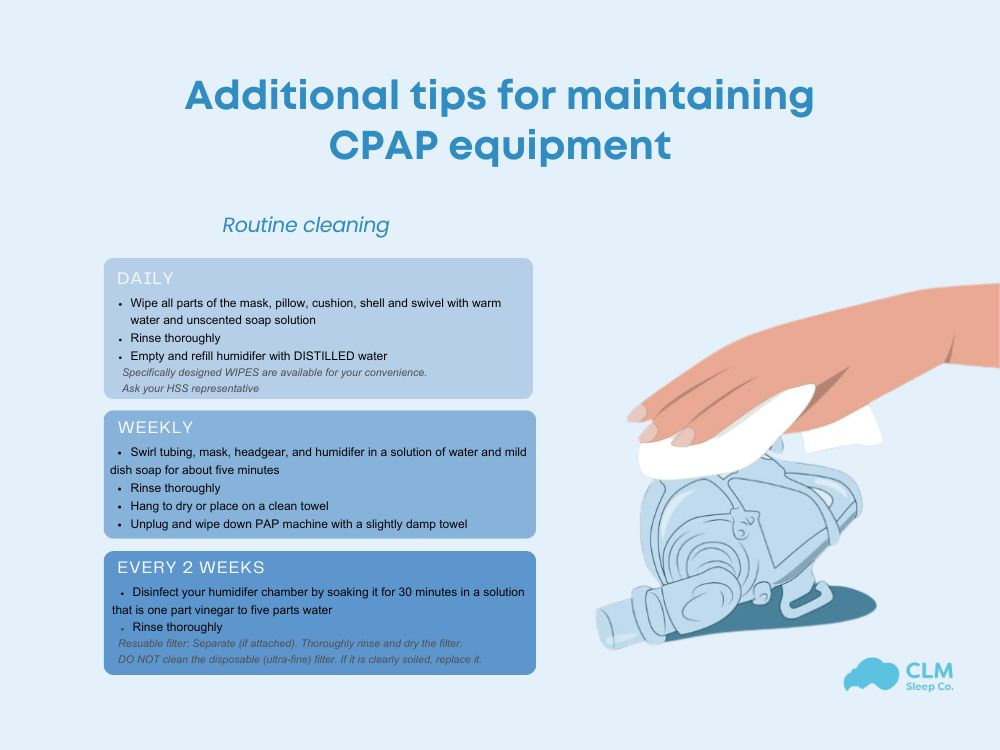
How to order replacement CPAP Parts in Australia?
Over time, CPAP components naturally wear out and need to be replaced to maintain the effectiveness and hygiene of your sleep therapy. Whether you need a new mask cushion, tubing, filters, or a humidifier chamber, knowing where and how to order replacement parts can make the process easier. It can also help you avoid unnecessary delays in your treatment. Below is a detailed guide to help you order CPAP replacement parts safely and efficiently in Australia.
Where to Buy
Always purchase CPAP replacement parts from licensed Australian medical suppliers or accredited sleep therapy clinics. These authorized vendors, such as CLM Sleep, offer genuine products that meet Australian health standards. They often provide customer support, product guidance, and troubleshooting assistance to help ensure you choose the right components for your device. Avoid ordering from unverified online marketplaces, as counterfeit or incompatible parts can pose safety risks and reduce your therapy’s effectiveness.
See more: Best Travel CPAP Machines in Australia
What to Look For
When selecting replacement parts, choose products from reputable manufacturers such as ResMed, Philips Respironics, or Fisher & Payke. These brands known for their quality and compatibility with a wide range of CPAP devices.
To ensure a proper fit:
- Check your CPAP machine’s model number (usually found on the back or bottom of the device).
- Compare part numbers or product codes before purchasing.
- Consult your supplier or sleep clinic if you’re unsure which part is compatible with your setup.
Many suppliers also provide compatibility guides online or offer phone/email support to confirm whether a part matches your specific model.
Warranty and Returns
Before finalizing your purchase, review the seller’s warranty and return policies:
- Reputable suppliers typically offer refunds or exchanges for defective or incorrect items.
- Keep a copy of your invoice or order confirmation in case you need to file a warranty claim later.
- Some products, such as masks or humidifier chambers, may have limited warranties based on the manufacturer’s guidelines.
Reading the fine print can help you avoid complications and give you peace of mind when replacing essential CPAP components.
Conclusion
Sticking to a regular CPAP replacement schedule is crucial for effective, safe, and comfortable sleep apnea treatment. Understanding how often to replace CPAP parts helps you stay ahead of wear and tear. Each component has its own lifespan and specific signs to watch for. By investing in timely replacements and sourcing from trusted Australian providers, you ensure that your therapy remains hygienic, effective, and hassle-free. Better maintenance leads to better sleep and better health.
Reference
1. Patil SP, Ayappa IA, Caples SM, et al. Treatment of adult obstructive sleep apnea with positive airway pressure: an American Academy of Sleep Medicine systematic review, meta-analysis, and GRADE assessment. .Journal of Clinical Sleep Medicine. 2019 Feb 15;15(2):301–334. doi: 10.5664/jcsm.7638. PMCID: PMC6374080 PMID: 30736888
2. Liu T, Li W, Zhou H, et al. Verifying the relative efficacy between continuous positive airway pressure therapy and its alternatives for obstructive sleep apnea: a network meta-analysis. Frontiers in Neurology. 2017;8:289.
